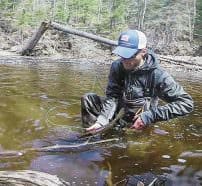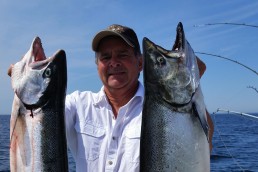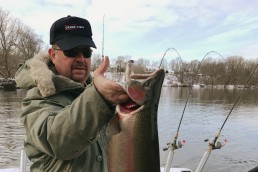Local Initiative for Helping Anglers Care for Steelhead Fisheries
SHARE THIS POST
Every spring, as air temperatures rise and the snow begins to melt, an annual phenomenon occurs on the North Shore of Lake Superior. Sensing this change in temperature and water flow, staging steelhead begin their annual push toward their native spawning grounds. As they begin to pile into the rivers, so do eager anglers, who have patiently waited all winter to do battle with these powerful fish.
While steelhead fishing is filled with triumph and defeat, there are some practices that threaten fragile steelhead populations across the country. Start Seeing Steelhead is a movement dedicated to educating anglers on proper handling techniques to benefit the steelhead fisheries. There are many misconceptions when it comes to steelhead, and they are not as tough as they feel on the end of the line. Steelhead are a fragile species that needs to be cared for so we can all continue to fish for them. If we, as fellow anglers, can curtail unnecessary mortality of steelhead by taking a few precautionary measures, not only will we see bigger, healthier fish in future years, but we will also help rebuild a fishery for the next generation of anglers.
Careful handling
Steelhead is a coldwater fish, and fragile when handled. The most common mistake made while handling is holding it by the gills. If a steelhead is harmed or bleeds from the gill area, its chances of living are severely reduced. This problem can be curtailed substantially if we keep our hands out of the gill area. By simply using one hand to grab above the tail, and the other to gently cradle the head and body below the pectoral fin, the problem can be alleviated. Be mindful not to squeeze the fish, because doing so could put unnecessary strain on their heart. If you see another angler grabbing a steelhead in an improper way, politely demonstrate how to properly hold the fish, because they simply may not know they are hurting it.

Just as steelhead should not be harmed in the gill area, they should also not be taken out of the water for more than a few seconds. Any significant amount of time out of the water will put unnecessary stress on them. This problem can be avoided by using a rubber mesh net. When the fish is ready to be landed, use the net to meet the fish in the deeper water where they feel comfortable, and keep the fish in the water until you are ready for your photo. This will help to keep the fish relaxed and recoup some of the energy it burned up.
“Beaching” a steelhead is never a good idea, because thrashing around on the rocks can cause their brains to swell. When you are ready to take your photo, gently lift and cradle the fish for a three-second count. The fish can then be placed back in the net while you assess your fishing partner’s photography skills.
Are you enjoying this post?
You can be among the first to get the latest info on where to go, what to use and how to use it!
Gentle release
Now for the best part of steelhead fishing: the release. As steelhead anglers, we have all shown our photos to someone at one time or another and have heard, “Did you keep it?” Then comes the confused look when you say the fish was released back into the river. Safely releasing a steelhead is just as important as landing it properly. If you’re wearing waders, use them by walking into knee-deep water to release the fish. This reduces the chance the fish will injure itself as it leaves your grasp. The fish should always be facing upstream so it can get the oxygen it needs flowing through its gills. Although it has been glorified on TV, moving the fish back and forth in the water is not a good idea, and it does not help the fish at all. The fish will let you know when it’s ready. Photos of a good release almost always look better than just holding the fish.
With proper handling and catch-and-release practices, we can not only protect and preserve steelhead populations, but also help to restore these great fisheries. If you are passionate about steelhead and would like to help with the movement, take a look at startseeingsteelhead.com and purchase a “Start Seeing Steelhead” window decal that’s available on the site. Part of the proceeds from each decal sale are donated to continue to help with steelhead rehabilitation. So not only will you be supporting the steelhead species, you will also be spreading awareness of proper handling techniques that will positively impact your steelhead fishing for years to come.
Contributions for this article came from Lauren Lehman, Sean Kinney, Ben Walsh, Rob Storrar, and Ken Petersen. They are the founders of the Start Seeing Steelhead movement.
MWO
SHARE THIS POST
Did you enjoy this post?
You can be among the first to get the latest info on where to go, what to use and how to use it!
Ken Petersen
MidWest Outdoors works with more than 200 outdoor experts each year, who contribute articles based on their areas of expertise. MidWest Outdoors magazine offers more fishing and hunting articles than any other publication!



